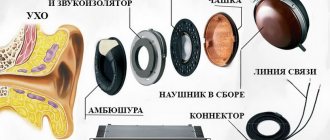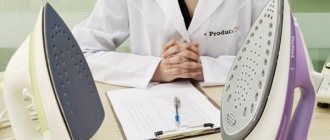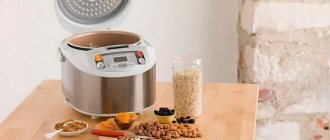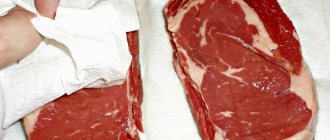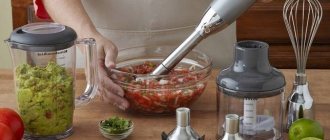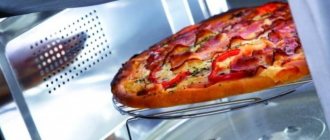Hearing the word “pressure cooker”, someone may raise their eyebrows in surprise and ask: “What is that?” Others nod with understanding: “Oh, yes, of course, my grandmother cooked cabbage soup in it!” And to be fair, it is not at all clear why this convenient and functional kitchen device turned out to be almost forgotten and not so in demand today.
For centuries, humanity has been striving to reduce the time spent on cooking.
What is a pressure cooker and how does it work?
To begin with, a small educational program. A pressure cooker is no different in appearance from a large saucepan. Its whole feature lies in the lid. The latter has the ability to fit very tightly to the container due to a special rubber seal. By placing the pressure cooker on the stove, you raise the temperature inside, thereby speeding up the cooking process.
A pressure cooker is perfect for those who often go on diets and adhere to a healthy diet.
When the lid is tightly closed and the stove is heated to maximum, steam is formed inside, which increases the pressure in the pressure cooker. And the temperature inside rises from 100 to 121 degrees Celsius.
When the maximum pressure is reached (usually this moment is determined using a special sensor or a pop-up rod), the outlet valve opens and excess steam escapes, maintaining the maximum possible temperature inside this unusual pan.
The main feature of a pressure cooker is the reduction of cooking time.
It is worth noting that Soviet-era models for gas stoves also worked on the same principle. As they say, the new is the well forgotten old. By the way, it is these models of the last century that are distinguished by long-term operation. They may not have a very aesthetic appearance, but in terms of their performance characteristics they will give a head start to any modern unit.
There are also electric models that provide the ability to automatically adjust the temperature and pressure levels. Such devices are great for soaking grains or legumes.
With the help of such a household appliance, you can save more than 70% of nutrients.
Modern pressure cookers have special grates (or grids) on which food is placed. It is better to lay them out in such a way that they do not touch each other and are evenly steamed. Such nets are placed above the water, at a distance of at least 2 centimeters. This allows evaporation to occur and creates the necessary vapor pressure.
Describing the principle of operation of a pressure cooker in a nutshell, we can say that it is fast, tasty and as healthy as possible.
Much less air accumulates in a pressure cooker, which oxidizes food, than in a simple saucepan.
Advantages and disadvantages
The advantages of this device are obvious. When there is a catastrophic lack of time and total workload, a pressure cooker will solve the problem of a quick and tasty lunch or dinner. According to some estimates, with its help you can cook 70% faster than in a regular pan. At the same time, it requires less energy for cooking (about 50-70%).
The appearance and taste of the dish remains at a high level.
Another indisputable advantage is a greater amount of useful vitamins and microelements that are preserved during the cooking process in a pressure cooker. After all, cooking requires less water, which means that useful elements are not diluted, but are preserved in the state necessary for a person.
You can cook any food in a kitchen container, including desserts. It is also allowed to defrost meat and vegetables.
Finally, because food is cooked very quickly in a pressure cooker, food retains its color and, as a result, soups, side dishes and meat dishes are more attractive in appearance.
There are also disadvantages, which, however, is not surprising, since the perfect kitchen gadget has not yet been invented! First of all, you will have to figure out how to use a pressure cooker first. And at the next stage you will need to get a little accustomed to the unusual process. But then, rest assured, everything will go like clockwork.
Dishes can be steamed without adding water to the container.
In particular, it will be necessary to re-determine the amount of liquid. It is clear that you will need much less of it than for cooking in a regular pan, but too little water is bad. The food will burn to the bottom.
Another nuance is control over the degree of readiness. With an ordinary saucepan everything is clear: I lifted the lid and assessed the process. And when cooking in a pressure cooker, you need to take into account that at maximum pressure the lid is locked (this is necessary for safety). To open the lid, you first need to release the pressure and then open it. All this takes time.
A distinctive feature is the operating principle of the pressure cooker.
Finally, because the process happens faster than in a saucepan, even a few extra minutes will result in the dish being overcooked.
And yet, you must admit, the disadvantages of a pressure cooker are rather conventions that can be resolved by simply getting used to using this device.
The container is equipped with a tight lid and, when preparing various dishes, it is firmly fixed to the product.
Principle of operation
In appearance, a pressure cooker is practically no different from a saucepan. A distinctive feature is the operating principle of the pressure cooker.
The container is equipped with a tight lid and, when preparing various dishes, it is firmly fixed to the product.
It lies in the design of the device itself. The model is equipped with a tight lid, and when preparing various dishes it is firmly fixed to the product. Liquid is poured into the vessel, which boils under the influence of temperature and forms steam. In turn, it is compressed because it is under the lid. High pressure and temperature heat the products, which are subsequently cooked without losing shape and color. When the pressure reaches its maximum point, a special hole opens to slowly release steam.
There are a huge number of models on the household appliances market. Some of them run on electricity.
Multicooker or pressure cooker: comparative analysis
A multicooker is an amazing device with many different functions. Some rightfully believe that it is a worthy descendant of the pressure cooker. Let's try to figure it out.
A multicooker or pressure cooker has been decorating more than one kitchen for several years now.
The name itself eloquently indicates that a multicooker is a multi-functional specialist: it can cook, stew, fry, and bake. The indisputable advantage of this device is that it is capable of automatically controlling the process and does not require human intervention after all the products have been added and a certain mode has been selected.
Their appearance, and most importantly, their help in cooking, has become an undeniable advantage when choosing between buying a multicooker or a set of frying pans.
The multicooker also has the ability to heat up and maintain a set temperature for a certain time.
The delayed start function allows you to prepare lunch or dinner exactly at the specified time. During the cooking process, healthy elements are preserved in dishes.
Slight heating of the case indicates the safety of this device.
Mentioning the shortcomings, we note the following:
- High price (especially if you are looking for a model with many features);
- Low cooking speed.
Comparing the advantages and disadvantages of both devices, the fact is obvious: the answer to the question of what to choose depends on your specific needs.
To diversify the number of dishes, you can find many interesting and new recipes on the Internet.
For example, if you prioritize safety (perhaps because there are small children in the apartment), then a multicooker is undoubtedly the best choice. In addition, a multicooker will allow you to experiment with recipes and available programs.
If the main thing for you is to quickly prepare dinner or lunch, then, of course, a pressure cooker will cope with this task much better.
To clean stains from your slow cooker, sprinkle the bottom of the container with baking soda and add a small amount of white vinegar. After some time, wash with warm water and soap.
What is better to cook in a pressure cooker?
Of course, in the time of our grandparents, the issue of preserving nutrients in products during cooking was not so pressing. Therefore, in many families, pressure cookers were used literally mercilessly. They stewed potatoes, cooked cabbage soup and other delicacies in them.
Most models are characterized by the presence of grates or meshes where products are placed.
However, the peculiarity of the “production process” - heating under pressure - indicates that it is best to cook soups or stews in a pressure cooker. Ideal foods for this device are legumes, whole grains, and a variety of cereals. Firm vegetables such as beets or carrots are also suitable.
It is thanks to pressure, which plays a major role in the cooking process, that the beneficial properties of these products are revealed, as they say, “in all their glory” and nourish our body with not just healthy, but also delicious dishes.
Meat, fish and vegetables should be placed in such a way that they are not close to each other.
For example, to cook chickpeas or beans in a regular pan, you will have to spend more than an hour. And the pressure cooker will do this for you within 20 minutes. As they say, feel the difference!
Or, every housewife is familiar with the situation when you want to make a vinaigrette, but because the beets take a long time to cook, you have to postpone preparing your favorite dish until the weekend. And in a pressure cooker, beets will cook in a matter of minutes.
It is important that the steam is evenly distributed and the dish is processed efficiently.
Even aromatic broth from fresh beef can be cooked in an hour. And you don’t have to stand at the stove for half a day and control this process.
Cooking under pressure
Cooking quickly is the dream of housewives of all times. However, this problem worried not only women. After all, the pressure cooker was invented by the French scientist Denis Papin, for which I bow to him.
The advantages of a pressure cooker over a regular saucepan are obvious. First of all, it allows you to quickly cook meat, beets, peas, beans, etc. Dishes cooked in a pressure cooker have a special rich taste. And thanks to accelerated cooking, the maximum amount of vitamins and nutrients is retained in the products.
How to reduce blood pressure
Experienced housewives claim that your ability to reduce pressure in a pressure cooker is the key to success in preparing tasty and healthy dishes.
You can do this in three ways:
- Natural reduction occurs due to turning off heat (gas or electricity);
- You can artificially reduce the pressure by placing the pan under running cold water;
- A quick reduction is possible if you open a special valve on the lid of the pressure cooker.
Often, vegetables and beans are cooked in such a container, since it takes a lot of time to cook them in a saucepan.
Natural pressure reduction is not a quick process. It takes from 5 to 20 minutes. This period depends on the amount of ingredients and their density. An important nuance: with prolonged cooling, meat or fish, as well as legumes, only become tastier, but vegetable stews quickly turn into porridge and lose their taste.
The main thing is to choose the right recipe and cook according to the algorithm.
Cold water and a special valve are an ideal way to reduce pressure while cooking grains and vegetables. This is a kind of “first aid” to reduce blood pressure and stop the cooking process.
The secret to a delicious pressure cooker dish is an accurate recipe and equally accurate cooking time. Then you can be sure that your culinary masterpiece will be appreciated.
It is recommended to clean the product and its components manually without using hard sponges or brushes.
Important! Before cooking in the pressure cooker, please read the operating instructions carefully. At first glance, this is a truism, but, you see, not every housewife bothers herself with such reading material. But in vain. There are nuances that distinguish pressure cooker models, and it is these that are very important to take into account when operating a particular device.
Cooking times for different foods
Due to the pressure created, the time for cooking in a pressure cooker is reduced. At the same time, more vitamins are preserved.
You need to cook the dish according to the time, taking into account the size of the food being cut into it. The larger the food, the longer it takes to cook. Approximately the meat will be cooked in minutes:
- After pre-frying small pieces:
- beef 8-10;
- lamb 10-12;
- veal or pork 12-15.
- Large piece:
- veal, rabbit 25-35;
- beef 30-50;
- lamb 30-40;
- tongue 30 -40.
- Whole poultry:
- chicken 15-20;
- chicken 20-30;
- duck 20-25.
Vegetable cooking time:
- beets 10-35 (old ones longer);
- carrots 5-9;
- unpeeled potatoes 15;
- corn cobs 15-20.
Rules of care
To ensure that your pressure cooker does not turn out to be a disposable gadget, but serves you for many years, take into account simple tips for caring for it.
- Allow the pressure cooker to cool before cleaning;
- Use the container only on the hob. Do not reheat or cook in the microwave or oven;
- Wash only by hand and only with soft sponges. No metal brushes!
- When cooking in a pressure cooker, do not overdo it with vegetable oil. A very small amount is enough;
- Only start cleaning the device when there is no food left in it.
An electric pressure cooker requires the same maintenance methods as a standard one.
The care rules are the same for modern pressure cookers and for Soviet-style models.
And a few more important points:
- Before you start cooking, make sure the pressure valve is clean and free of food residue. If you find them, remove them with a toothpick;
- The rubberized gasket on the cover must be undamaged. If this is not the case in your case, you will not be able to close the lid tightly, which means the cooking technology will be disrupted. It is worth replacing with a new component;
- During washing, the temperature should increase gradually (since you should only start washing a cooled device). Temperature fluctuations negatively affect the condition and performance of the pressure cooker;
- Remove remaining food only after the appliance has cooled completely.
Before use, make sure that there are no food residues inside the vessel.
Be careful to ensure that the pressure cooker does not have any chips or cracks through which steam may escape. Not only will this disrupt the cooking process, you risk serious burns. So this point deserves the most serious attention.
The pressure cooker is undoubtedly a worthy invention. We can safely say that it has stood the test of time and proven its worth, even in competition with modern multicookers and double boilers. Decent in all respects and capable of many things, the pressure cooker deserves to take its place in your kitchen.
By following the above mentioned maintenance methods, you will be able to use your pressure cooker for many years.
Give a pressure gauge to your favorite pressure cooker!
A tale for beginner heating engineers.
People invented pressure cookers more than 200 years ago, and at first they took them very seriously.
They tried everything, and the peak in evolution, in my opinion, was reached by the American pressure cookers of the 1950s. After which, as usual, manufacturers gradually relaxed, the triumph of heating technology gave way to marketing, and now most mass-produced pressure cookers have a simplified design. My review is for those who have decided to fight regression on their own, and are ready to introduce into the design of their favorite pressure cooker the most important device for it - a pressure gauge. After such an upgrade, cooking will become clearer and safer
.
How to achieve this? First of all, evaluate the technical condition of the pressure cooker, even if it is new.
First I'll show you how I installed the pressure gauge on a small (3L) Bergner BG-4606 aluminum pressure cooker.
The Chinese company HONGOi produces good 40 mm axial and radial pressure gauges for different pressures.
For unforced pressure cookers, the operating pressure does not exceed 1 atmosphere (0.1 MPa)
, so the most suitable value is 0.16 MPa.
Let's consider and measure
the radial version
(i.e., a design in which the fitting extends radially from the round pressure gauge body). The front side of the case is sealed with rolled glass.
On the back there are 2 screws that secure the tin housing to the pressure gauge mechanism.
That is,
the pressure gauge is not dismountable
- if, for example, glass is broken, then it will not be possible to replace it without tricks. Well, there are no eternal things at all, let’s take this feature into account and be careful when working with the pressure gauge! Well, before we start working, let's measure it. First, the declared body diameter:
Quite similar to a promise. Then we measure other dimensions:
And the connecting size of the shank (M10*1 thread):
Anyone who can read Chinese can read the instructions
The length of the shank requires modification of the standard fasteners. This is what the nut from the rear hub axis of the “Ukraine” bicycle looks like on the shank:
It can be seen that you will have to post-weld it to reduce the height of the nut.
I cut the nut lengthwise with a grinder with a 1 mm disc, sanded the ends on the side surface of the sharpener, and thoroughly (10 times) burned the nut, liberally lubricated with edible oil
This operation is easier to carry out for all the fasteners involved than to find ready-made ones with the required properties.
As a result, the shank should not create an extra cavity in the nut, where food debris will accumulate, and the nut should securely (2 turns) fix the pressure gauge
.
After which it is necessary to seal the pressure gauge from moisture penetration into the mechanism
. If this is not done, then when washing the pressure cooker, moisture will get inside the pressure gauge, it will lose its neat appearance and may even lose visibility. The easiest way to do this is with sealant.
The sealant must also be applied under the screws
, for which they must be unscrewed.
Even a medical autoclave has a temperature of only 132 C, so any sealant is suitable - there is no pressure on it in this place. For trial operation, I didn’t bother too much: I removed the emergency valve from the pressure cooker (the reduction in “automatic” safety is compensated by clarity) in order to use its flat seat. When the saddle is flat, regular rubber can be used for padding for a very short time.
The trial operation of the pressure cooker was considered successful by me.
Along with the obvious success, there was a strong intention to give the pressure cooker some irreparable changes - to return the emergency valve to its place
(there is no such thing as too much safety), and to use a newly made hole to place the pressure gauge, now not flat, because it is performed in the conical surface of the lid.
Fragile rubber was replaced with paronite.
In the photo you can see that after 5 years of operation, corrosion is more likely to corrode the original operating valve than a self-installed pressure gauge.
In addition, because This pressure cooker is small in height, but the axial design of the pressure gauge turned out to be more obvious in terms of ergonomics (no need to bend to look into the end of the pressure gauge from the side).
Judging by the nature of the damage the pressure cooker received during operation, it is clear that it was not idle. The axial pressure gauge looks good on a low pressure cooker, but I installed a radial version on the larger 4.5 liter Soviet Svarma pressure cooker.
I considered both options, and in comparison with the Soviet pressure gauge.
Initial state during revision
Fitting
The Soviet relic practically differs from the modern Chinese only in its disassembly (for example, the broken glass of a Soviet pressure gauge can be replaced)
, but it’s easier to buy Chinese ones.
About safety: all work must be carried out by carefully working with your hands under the control of a bright head
. For example, you cannot begin an inspection of the condition of an old pressure cooker without cold hydrotesting. The following valve can help with this:
how the modified pressure cooker behaves
by watching this video:
— Personally, I immediately start wanting to drink “something like that,” and my willpower quickly runs out.
Eventually:
1) you can force the pressure cooker (I succeeded), but here I take the example of the cunning Scheherazade and stop allowing myself speeches; 2) the pressure gauge made waiting for food more dynamic and added safety; 3) these pressure gauges are just a sight for sore eyes - they work great in other designs.
For example, a similar pressure gauge can also measure the pressure of tap water
Bon appetit!


